Interesting article give the 2 EQ's off Japan & Chile...Paste the link if you don't receive the images/can't access the links.
http://www.viewzone.com/gravitywaves.html
Be Well.
David
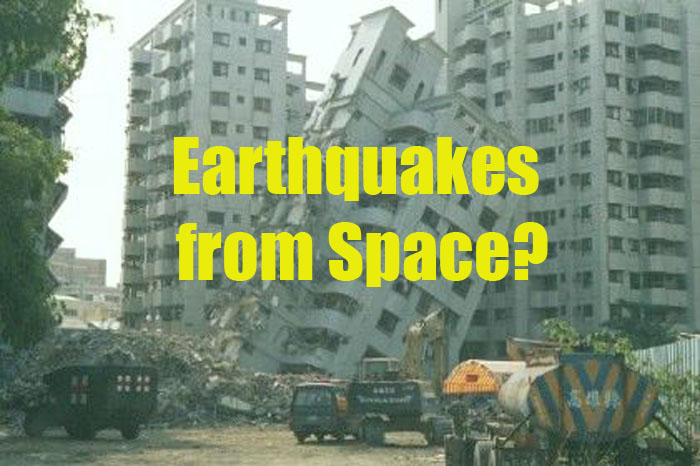
As usual, viewzone gave me an assignment that seemed literally out of this world. They asked me to investigate the theory that some major earthquakes can be caused by explosions far, far away in the universe. Although I'm not entirely convinced that this can happen, the evidence is pretty convincing.
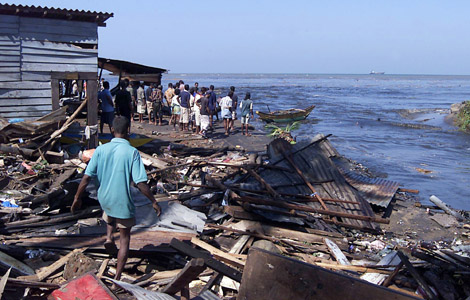
The idea started with one of the most powerful earthquakes that was ever recorded -- the magnitude 9.3 earthquake that occurred in the Indian Ocean off the coast of Sumatra in Malaysia on December 26th, 2004. It caused a powerful tsunami which devastated coastal regions of many countries leaving over 240,000 people either dead or missing. It was the worst tsunami to affect this area since the 1883 explosion of Krakatao. The earthquake that produced it was so strong that it exceeded by a factor of 10 the next most powerful earthquake to occur anywhere in the past 25 years.
Just 44.6 hours later, scientists were shocked to see that gamma ray telescopes orbiting the Earth picked up the arrival of the brightest gamma ray burst ever recorded! The Gamma ray burst (or GRB) arrived from deep space on December 27, 2004 at 21 hours 36 minutes (Universal Time) and was 100 times more intense than any burst that had been previously recorded. It equaling the brightness of the full Moon but radiated most of its energy at gamma ray wavelengths. The blast temporarily changed the shape the Earth's ionosphere, distorting the transmission of long-wavelength radio signals.
Was there a relationship between these two dramatic events? Perhaps.
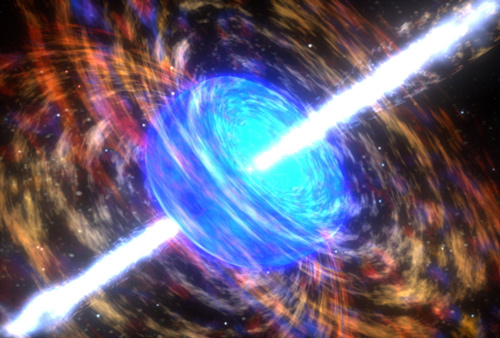
When stars die, they typically expand and give off a lot of energy. If a star is large enough, the core will collapse and a tremendous amount of energy will be released in a supernova explosion. This is so powerful that a single supernova will be brighter than an entire galaxy full of hundreds of billions of stars! But the very brightest supernovae, the biggest stars that explode, can produce ultra-powerful jets that shoot out in opposite directions. If one of those jets (which are really narrow, only about one degree wide) is pointed directly at us, we get bathed in a whole lot of extra energy even beyond what a supernova can do, and that's called a gamma ray burst.
Gamma rays are the most lethal form of radiation. These are the kind of rays that kill people from an atomic blast. The gamma rays can penetrate deep inside biologic tissue and alter molecular structures and rip apart the very basis of life. We are extremely lucky that we have not experienced a close encounter with a gamma ray burst -- most have been many light years away -- because if we had, you would not be reading this.
Gamma ray bursts are detected frequently in our universe. Most of the bursts are outside our Milky Way Galaxy, far, far away. Satellites detect these bursts and report on their position and strength, often allowing astronomers to look at the sources and try to understand what causes them. Although most are thought to be collapsing stars or black holes, others remain a mystery.
Gamma Rays and Gravity waves
Astronomers have theorized that gamma ray bursts might travel in association with gravity wave bursts. The same events, such as a rapidly collapsed star, which cause the release of gamma rays also is thought to make a "ripple" in the time-space continuum that is manifested as a gravity wave.
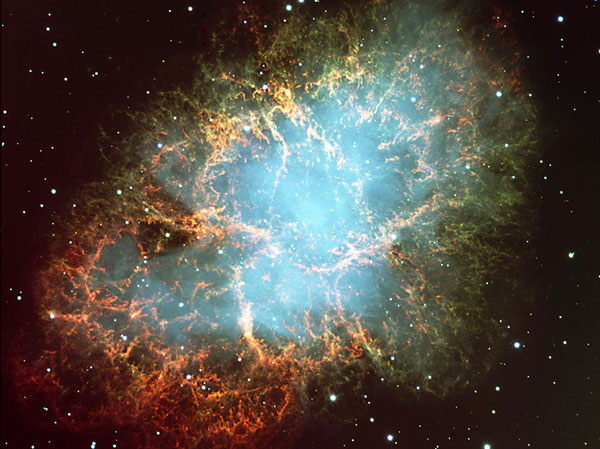
The "Crab Nebula" is the remnant shell of a star that exploded many light years ago. At the time it collapsed on itself, it would have sent out powerful gamma ray bursts and gravity waves.
In the course of their flight through space, gamma rays would be deflected by gravitational fields and would be scattered by dust and cosmic ray particles they encountered, so they would be expected to travel slightly slower than their associated gravity wave burst which would pass through space unimpeded.
In this analogy, if space were a liquid, gamma rays would be energy traveling through the liquid whereas the gravity wave would be the waves of the liquid itself.
After a 45,000 year light-speed journey, a gamma ray burst arrival delay of 44.6 hours (as in the case of the December 2004 earthquake/gamma ray burst) would not be unexpected. It amounts to a delay of just one part in 9 million.
So if the gravity wave traveled at the speed of light (c), the gamma ray burst would have averaged a speed of 0.99999989 c, just 0.11 millionths slower. There is also the possibility that at the beginning of its journey the gravity wave may have had a superluminal (less than velocity of c) speed.
Still with me on this? Here's what's going on so far:
Collapsing stars release massive amounts of energy that travel outward in the form of powerful gamma rays, called gamma ray bursts. These huge explosions last only minutes but can be detected from orbiting satellites. These violent explosion also causes a ripple in the very fabric of space-time -- like a stone thrown in a pond -- that travels outward as a gravity wave. Both the gamma rays and gravity wave propogate outward at different speeds, often reaching the earth at different times.
So What is a Gravitational Wave?
Most scientists describe gravitational waves as "ripples in space-time." Just like a boat sailing through the ocean produces waves in the water, moving masses like stars or black holes produce gravitational waves in the fabric of space-time. A more massive moving object will produce more powerful waves, and objects that move very quickly will produce more waves over a certain time period.
Where Do Gravitational Waves Come From?
Gravitational waves are usually produced in an interaction between two or more compact masses. Such interactions include the binary orbit of two black holes, a merge of two galaxies, or two neutron stars orbiting each other. As the black holes, stars, or galaxies orbit each other, they send out waves of "gravitational radiation" that reach the Earth, However, once the waves do get to the Earth, they are extremely weak. This is because gravitational waves, like water waves, decrease in strength as they move away from the source. Even though they are weak, the waves can travel unobstructed within the 'fabric' of space-time. This how they are able to reach the Earth and provide us with information that light cannot give.

Gravitational waves have two important and unique properties. First, there is no need for any type of matter to be present nearby in order for the waves to be generated by a binary system of uncharged black holes, which would emit no electromagnetic radiation. Second, gravitational waves can pass through any intervening matter without being scattered. Whereas light from distant stars may be blocked out by interstellar dust, for example, gravitational waves will pass through unimpeded. These two features allow gravitational waves to carry information about astronomical phenomena never before observed by humans.
What are the effects of a passing gravitational wave?
[Top Right]The effect of a plus-polarized gravitational wave on a ring of particles.
[Bottom right]The effect of a cross-polarized gravitational wave on a ring of particles.
 Imagine a perfectly flat region of spacetime, with a group of motionless test particles lying in a plane. Then, a weak gravitational wave arrives, passing through the particles along a line perpendicular to the plane of the particles. What happens to the test particles? Roughly speaking, they will oscillate in a "cruciform" manner, as shown in the animations. The area enclosed by the test particles does not change, and there is no motion along the direction of propagation. In the animation at the right, the wave would be passing from you, through the screen, and out the back.
Imagine a perfectly flat region of spacetime, with a group of motionless test particles lying in a plane. Then, a weak gravitational wave arrives, passing through the particles along a line perpendicular to the plane of the particles. What happens to the test particles? Roughly speaking, they will oscillate in a "cruciform" manner, as shown in the animations. The area enclosed by the test particles does not change, and there is no motion along the direction of propagation. In the animation at the right, the wave would be passing from you, through the screen, and out the back.
The foregoing animation is the result of a pair of masses that orbit about each other (e.g., black holes) on a circular orbit or a rotating rod or dumbbell. In this case the amplitude, A, of the gravitational wave is a constant, but its plane of polarization changes or rotates (at twice the orbital or rotating-rod rate) and so the time-varying gravitational wave size or periodic spacetime strain h, exhibits a variation as shown in the animation. If the orbit is elliptical or the rotating rod's centrifugal-force change varies during rotation, then the gravitational wave's amplitude (that is, the amplitude of the periodic spacetime h), A, actually also varies with time according to an equation called the "quadrupole".
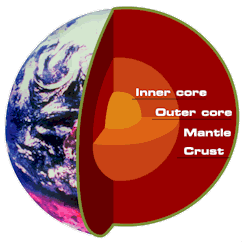 The effect of Gravity Waves on the Earth
The effect of Gravity Waves on the Earth
In his 1983 Ph.D. dissertation, Paul LaViolette called attention to terrestrial dangers of Galactic core explosions, pointing out that the arrival of the cosmic ray superwave they produced would be signaled by a high intensity gamma ray burstgravity wave that might be expected to travel forward at the forefront of this superwave and might be the first indication of a superwave's arrival. He pointed out that such gravity waves could induce substantial tidal forces on the Earth during their passage which could induce earthquakes and cause polar axis torquing effects. which would also generate a strong
If a gravity wave can distort the space between matter, even on a small scale, the cumulative effect of the earth's core, with its dense mass, and the mantle could result in movement of the crust. The result would be an earthquake.
While we still do not know the relationship of the arrival on earth of the gamma ray burst and the gravity wave, we would expect that they should coincide within several hours of eachother. To test this hypothesis, we have researched the most notable gamma ray bursts from 1967 to the present.
| Strong Gamma Ray Burst (date) | Earthquake Reported (date) |
| GRB 20100219A -- This gamma ray blast, on February 19, 2010, was recorded by the SWIFT satellite at 15:15:46 Universal Time at RA 10:16:52 DEC -12:33.32 | On February 27, 2010 a magnitude 8.8 occurred off the coast of Chile. It was the strongest earthquake to strike the region in 50 years and generated a tsunami that impacted the entire Pacific rim area. |
| GRB 100111A -- This gamma ray blast, on January 11, 2010, was recorded by the SWIFT satellite at 04:12:49 Universal Time at RA 16:28:09 DEC 15:33:24 | On January 12, 2010 a magnitude 6.8 occurred in Haiti, destroying buildingd and infrastructure and causing over 200,000 deaths. |
| GRB 670702 -- On July 2, 1967, the first GRB, 670702, was detected by the Vela 4 satellite. | A moderate earthquake measuring ML 4.1 (NCSN), Mw 4.1 (UCBSL) occurred at 17:33:53 UTC (10:33 a.m. local time), July 2, 1967 in the hills of Central California south of Hollister, but was too weak to topple any items from tables or shelves. |
| GRB 990123 -- Astronomers obtained a visible-light image of GRB 990123 as it occurred on January 23, 1999, using the ROTSE-I telescope, sited in Los Alamos, New Mexico. The robotic telescope was fully automated, responding to signals from NASA's BATSE instrument aboard the Compton Gamma Ray Observatory within seconds, without human intervention. This was the first GRB for which optical emission was detected before the gamma-ray emission had ceased. GRB 990123 had the brightest measured optical afterglow until GRB 080319B. GRB 990123 momentarily reached exceeded magnitude 8.9, and would have been visible with an ordinary pair of binoculars in spite of its distance of nearly 10 billion light years from Earth. | El Quindio, Columbia Earthquake , January 24, 1999: Reconnaissance Report. Eduardo A. Fierro, tech ed. On January 24, 1999 a 5.9 magnitude earthquake struck the western part of Colombia, causing more than 1,000 deaths and thousands of injuries. Within a matter of seconds entire city blocks were destroyed and thousands left homeless. Much of the damage resulted from poor construction and large amplifications of ground motions due to soft soil conditions. Numerous landslides disrupted roads and impeded emergency response. |
| GRB 970228 -- On February 27, 1997 the BeppoSAX satellite detected GRB 970228 and its afterglow. This was the first GRB with a successfully detected afterglow. The location of the afterglow was coincident with a very faint galaxy, providing strong evidence that GRBs are extragalactic. | Earthquake felt across much of UK Feb. 27, 1997. The earthquake caused damage to many homes and wasn the biggest earthquake in the UK for nearly 25 years. People in Newcastle, Yorkshire, London, Cumbria, the Midlands, Norfolk and also parts of Wales, felt the tremor just before 0100 GMT. The British Geological Survey (BGS) said the epicentre of the 5.2 magnitude quake was near Market Rasen in Lincolnshire. |
| GRB 970508 -- May 8, 1997, was the first with a measured redshift, z = 0.835, confirming that GRBs are extragalactic events. The extent to which radiation is redshifted allows astronomers to calculate an estimate of the distance to the event from Earth. | May 10, 1997: The Ardekul Earthquake northern Iran. Magnitude 7.3, Depth 33km. |
| GRB 080313 -- At 5th magnitude March 13, 2008 was an extremely intense GRB with the brightest visible afterglow ever. It was bright enough to see with the naked eye. At the time it was the most energetic event detected by Swift and the most luminous optical source ever recorded. | Magnitude 7.2 - XINJIANG-XIZANG BORDER REGION, the March 20, 2008 event is one of the largest known historical earthquakes to have occurred in the northern Tibetan Plateau. 2008 March 20 22:33:00 UTC Preliminary Earthquake Report. Magnitude 4.3, Semnan Province Tuersday, March 18, 2008 at 03:56:49 (UTC). March 18, 2008 at 03:56:49 ... Magnitude 3.3, E of Glacier Peak, WA Monday March 17, 2008 at 04:58:48.26 PM (PDT) |
| GRB 080913 -- At 12.8 Gly and redshift of z = 6.7, September 13, 2008 was the most distant GRB observed to date. This stellar explosion occurred around 825 million years after the Big Bang. | The USGS reports that a series of 4.5-4.8 magnitude earthquakes occurred on Thursday, September 11, 2008 between 5:17 p.m. and 7:26 p.m. EDT, 177-180 miles west of Neah Bay, Washington, at a depth of 6.2 miles. There were no reports of damage or injury and no tsunami was generated. September 10, 2008 -- UAE hit by tremors after Iran earthquake. Dubai: Severe tremors were felt in Dubai, Sharjah, Ajman and other parts of the emirates at around 3.08pm local time forcing people to flee from homes and office. Magnitude 6.6 HALMAHERA, INDONESIA September 11, 2008. |
| GRB 080916C -- which occurred on September 16, 2008 in the constellation Carina and recorded by the Fermi telescope has been confirmed to have "the greatest total energy, the fastest motions, and the highest-energy initial emissions" ever seen. The explosion had the power of about 9,000 ordinary supernovae, and the gas bullets emitting the initial gamma rays must have moved at 99.9999 percent the speed of light. The tremendous power and speed make this blast the most extreme recorded to date. | Strong 6.1 Earthquake East Timor 09/16/08, Indonesian seismological officials said the earthquake was 6.3. Tuesday, September 16, 2008 07:15:41 PM, Earthquake measuring 4.7 shakes Maharashtra. The earthquake occured on Tuesday, September 16, 2008 at 21:47:14 UTC (Coordinated Universal Time ) and on Wednesday, September 17, 2008. |
| GRB 041227 -- This gamma ray blast, on December 27, 2004, was 100 times more intense than any burst that had been previously recorded, equaling the brightness of the full Moon, but radiating most of its energy at gamma ray wavelengths. Gamma ray counts spiked to a maximum in 1.5 seconds and then declined over a 5 minute period with 7.57 second pulsations. The blast temporarily changed the shape the Earth's ionosphere, distorting the transmission of long-wavelength radio signals. | On December 26, 2004 a magnitude 9.3 earthquake occurred in the Indian Ocean off the coast of Sumatra in Malaysia. It caused a powerful tsunami which devastated coastal regions of many countries leaving over 240,000 people either dead or missing. It was the worst tsunami to affect this area since the 1883 explosion of Krakatao. The earthquake that produced it was so strong that it exceeded by a factor of 10 the next most powerful earthquake to occur anywhere in the past 25 years. |
So what's the verdict?
It appears that there is a link between the gamma ray bursts and the strong earthquakes. But this link assumes that the gamma ray bursts were associated with strong gravity waves. Unfortunately we do not have a record of gravity waves as they are felt on earth. In fact, they are still only theoretical.
In 1918, Albert Einstein predicted that cosmic events, such as collapsing stars, would radiate a propagating distortion of space and time -- gravitational waves. But after spending hundreds of millions of dollars to detect them, scientists have still come up empty.
Physicists worldwide have been fine-tuning enormous, multimillion-dollar machines to filter out background noise so they can observe the unique signatures of a gravitation wave. Before the decade is out, they believe they'll record the percussive crash of colliding black holes or the vibrant hum of a pulsar -- a discovery that would be the proverbial shot heard around the scientific world.
 Stefano Foffa [right] of the University of Geneva is a member of a leading gravitational-wave-detection team, which includes 33 other scientists from Switzerland and Italy. They recently submitted a report to Classical and Quantum Gravity that details their so-far fruitless attempts at observing tiny gravitational tugs and distortions on Explorer, a supercooled, 3-meter-long aluminum bar at the CERN particle physics lab in Switzerland.
Stefano Foffa [right] of the University of Geneva is a member of a leading gravitational-wave-detection team, which includes 33 other scientists from Switzerland and Italy. They recently submitted a report to Classical and Quantum Gravity that details their so-far fruitless attempts at observing tiny gravitational tugs and distortions on Explorer, a supercooled, 3-meter-long aluminum bar at the CERN particle physics lab in Switzerland.
Explorer is particularly well-tuned to sense spinning neutron stars, also known as pulsars, Foffa said. He and his colleagues estimate that some 200,000 of these spinning, super-dense objects -- so dense that a just sugar cube-sized amount weighs as much as the entire human race -- are scattered throughout the Milky Way.
But the thermal noise of even supercooled atoms is greater than the momentary twang the bar's atoms would experience when being plucked by a passing gravitational wave. So the Explorer group must use sensitive superconducting circuits to coax out a signal. It's an art that's still being perfected.
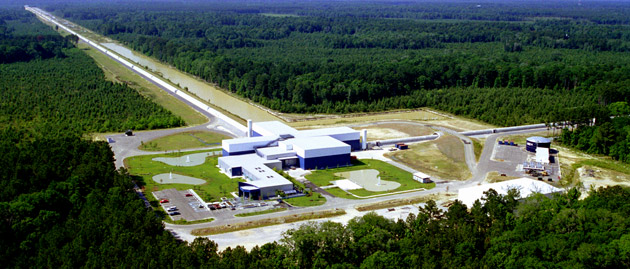
LIGO, the Caltech-MIT observatory, is an even bigger and more ambitious project than Explorer. To someone flying overhead, LIGO looks like an unfinished oil pipeline, with two mile-and-a-half long tubes jutting in perpendicular directions from a central building. The pipes (one in Livingston, Louisiana, and the other in Richmond, Washington), contain sensitive optics in which laser light bounces back and forth 100 times, then combines, allowing physicists to compare the two beams to monitor the space-time through which the light traveled.
The interference patterns from LIGO's two perpendicular laser beams sometimes momentarily jostle. If the same jostling happens at both LIGO's Louisiana and Washington detectors, and no earthquakes can explain the anomaly, then the source may well be a gravitational wave.
So, it's the million-dollar moment that hasn't yet happened. Or has it?
It could be that the effects of a relatively weak gravity wave can only be detected through the changes to some massive object, such as the earth's core. In that case the gravity wave theory may already have been validated by its association with earthquakes.
So there you have it.





No comments:
Post a Comment